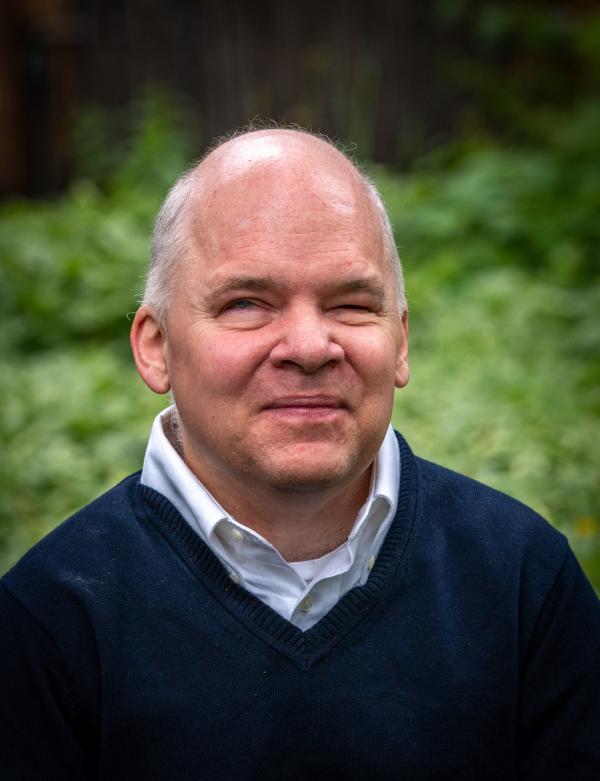Health Care Is Not Designed for Those Who Need It Most
Matthew Weed Delivers Powerful Talk on Making Health Care Accessible to All
BY JOHN CARLO J. COMBISTA, NIMH
More than half of all U.S. adults have at least one chronic health condition and 1-in-4 adults has a disability, according to the Centers for Disease Control and Prevention. Disability and health care go hand in hand, and yet health care remains far behind the curve in making care and health-related information accessible.
Matthew Weed, a health care accessibility consultant with a doctorate in genetics, spoke about bridging this gap at NIH.

CREDIT: MATTHEW WEED
Matthew Weed serves as a health care accessibility consultant to the NIH.
Weed is uniquely qualified to speak on the topic. His presentation, “Optimizing Outcomes for Patients with Chronic Illnesses and Disabilities,” was based on his personal struggles managing a chronic health condition (type 1 diabetes) and a disability (total blindness) while weaving in his contributions to helping NIH improve accessibility efforts.
Two main points Weed touched upon during his talk were:
- Translation of technological advancements into real-world use to ensure accessibility: Learning to use devices at home and alone can quickly get complicated, he noted, as he demonstrated blood glucose checks as a patient with visual impairment.
- Building infrastructure accessibility: Weed shared ways to make or keep NIH’s clinics and laboratories accessible to people with disabilities—from parking, elevators, and building passageways, to ramps, doors, and carpets. For example, he pointed out that most ramps are not actually accessible or safe and that all elevators should have sound prompts, such as one ding for up and two for down.
Accessible health information is imperative
Weed's work with NIH started in 1994 as a summer research trainee at NIEHS (Durham, North Carolina). While there, he toured with facilities management to help them ensure laboratory areas and outdoor sidewalks remained hazard-free and physically accessible. He later served as a science-trained beta tester on accessible PubMed from 1999 to 2010, and more recently, he worked to improve the accessibility of the NIH Library website for blind visitors.
Communication and community engagement make health care accessible to everyone, according to Weed. He pointed out that NIH ICs can enhance the accessibility of health information products such as brochures and reports. Weed emphasized that many of these materials are not easy to read on screen readers, a common tool used by people who are blind or visually impaired.
“The more difficult we make science and health information to navigate, the harder it will be to communicate with a lot of people out there,” Weed said. “Also, if we don’t think about how we communicate science, then scientists and health care professionals are always going to be behind in the battle to legitimize what we do.”
Real people, real world
Weed encouraged scientists and health care professionals alike to engage in the community outside of hospitals and laboratories to understand the needs of patients because health care happens everywhere. “Most science happens in the lab, but most of the effects of science happen in the real world.”
He advised NIH ICs and CCs create an advisory council inviting people with chronic illnesses and various disabilities to serve as representatives and be involved in the decision-making processes regarding accessibility. He also advocated more inclusion of people with disabilities in clinical trials.
The NIH does this to some degree, Weed said, but there is always room for improvement.
“This is really important to be conscious of because we know that these people are least likely to appear in appropriate numbers in clinical trials. We may be misspending a lot of money on trials because we are not matching them to the people who need them the most,” he said.
Changing attitudes
Growing up in Colorado Springs, Colorado, in the 1970s, he experienced firsthand the struggles of managing his diabetes, particularly when complicated by his total blindness. During the lecture, he demonstrated how still today common diabetes management is anything but accessible with unreadable medicine labels and the confusion caused by the shapes of medicine vials, insulin pens, and inhalable insulins—all with different dosages to be taken at various times and days.
Health care, put simply, is not designed for people with disabilities or language barriers, he said.
“The choices health professionals make, and the attitudes they carry, can have huge, huge impacts on patient outcomes and compliance,” Weed said. “Please do not add to our challenges by asking patients to overcome your negative attitudes as well as their health concerns. Rather, please help reduce the barriers we face by keeping open minds and seeing your patients as people, not health conditions.”
In spite of Weed’s blindness and lifelong battle with type 1 diabetes, he has managed to achieve more than most healthy and sighted individuals. In fact, he has earned five degrees from three Ivy League universities, including a doctorate in genetics. Obtaining these degrees was no easy feat considering the struggles he faced in addressing the accommodations he needed to succeed in his studies.
During his talk, he shared the abysmal percentage of medical students with physical and sensory disabilities who matriculated (0.56%) or graduated (0.42%) between 2001 and 2010 (PMID: 22450188).
Today, he dedicates time to “helping good people do great things” through mentorship and consultancy. He now uses those experiences he faced and overcame to mentor students of diverse backgrounds and health conditions by helping them apply to their dream undergraduate and graduate programs as well as helping them succeed throughout their studies.

John Carlo Jadormeo Combista is a predoctoral fellow in the NIMH Oligodendroglial Interactions Group under the supervision of Tobias Merson. He is interested in understanding how the brain develops and functions by exploring how patterns of myelination within specific neural circuits emerge. Outside of academia and writing, he is passionate about singing and volunteers his free time to work with vulnerable populations.
NLM Bionic Eye Video Describes Scenes for Visually Impaired Using AI
NLM is making health information accessible in meaningful ways.
Vision loss effects an estimated 18 million Americans, 710,000 of whom experience total blindness, according to the International Agency for the Prevention of Blindness 2020 Vision Atlas report.
As Matthew Weed advocates, communicators can take action to make health communication more accessible for people who are visually impaired. A video created by the National Library of Medicine (NLM) communication team used an artificial intelligence program called Audible Sight to enhance a video they developed about a retinal and brain implant called the Bionic Eye.
The video features an NIH Director’s New Innovator Award-winning project that brings together artificial intelligence, virtual reality, visual prostheses, and retinal and brain implants. The Bionic Eye is an assistive technology device that can help individuals who are blind to better navigate their surroundings.
The Bionic Eye video project offered the perfect opportunity to try out the new AI technology. The proprietary AI program swiftly generates audio descriptions for video scenes. What would take a human days to complete, the program can complete in minutes.
See, and hear, for yourself.
This page was last updated on Monday, December 2, 2024
